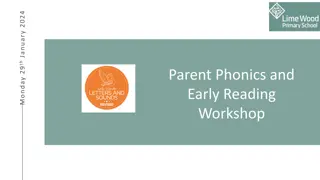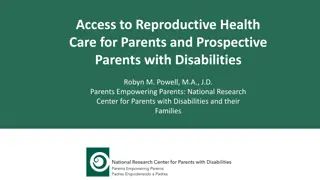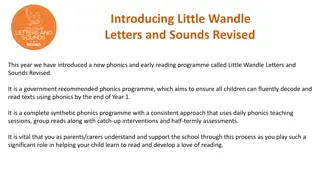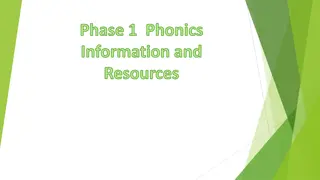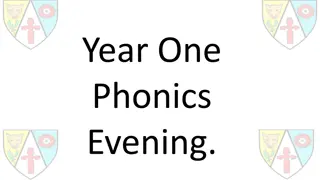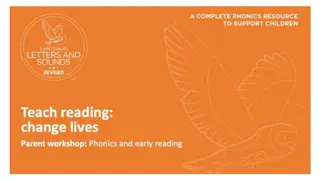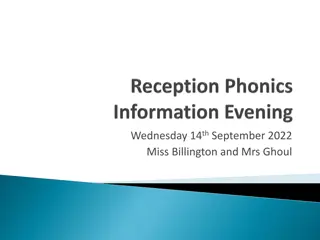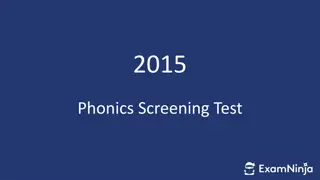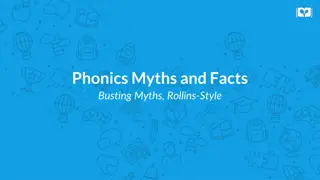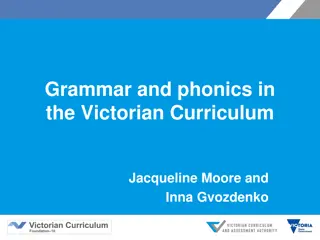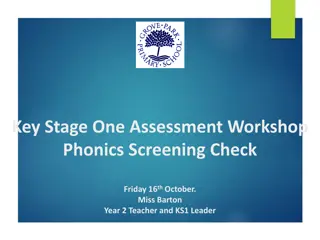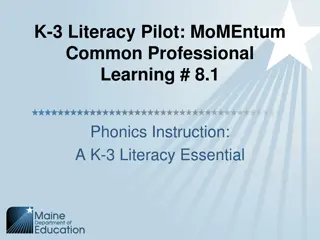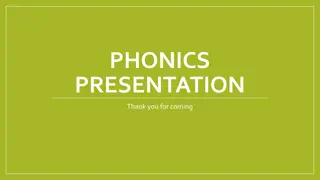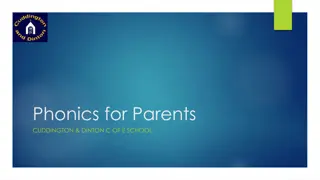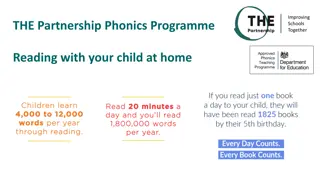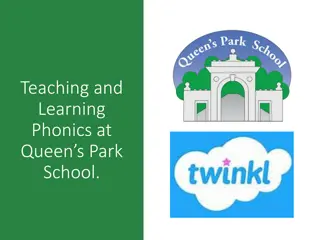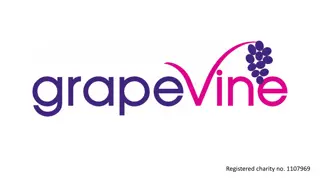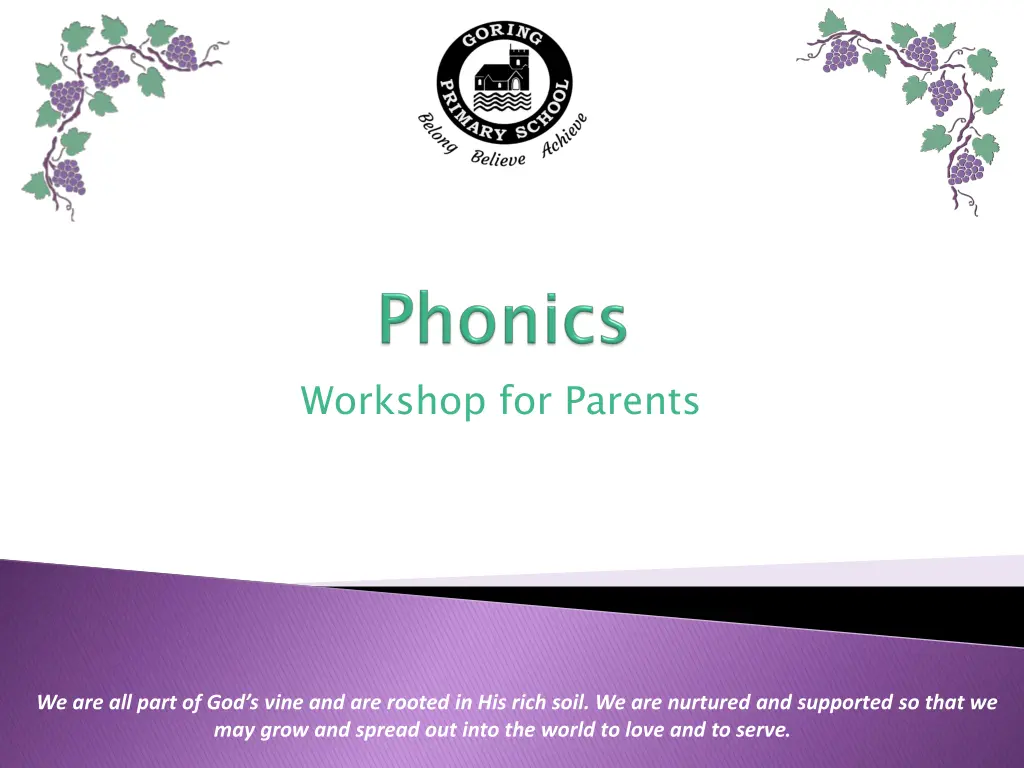
Interactive Phonics Workshop for Parents
Join our interactive workshop for parents to discover the importance of phonics in supporting children's word recognition and literacy skills. Learn about phonemes, graphemes, digraphs, and more to help your child become a successful reader. Enhance your understanding through activities like building and breaking down words, and correct pronunciation guidance.
Download Presentation

Please find below an Image/Link to download the presentation.
The content on the website is provided AS IS for your information and personal use only. It may not be sold, licensed, or shared on other websites without obtaining consent from the author. If you encounter any issues during the download, it is possible that the publisher has removed the file from their server.
You are allowed to download the files provided on this website for personal or commercial use, subject to the condition that they are used lawfully. All files are the property of their respective owners.
The content on the website is provided AS IS for your information and personal use only. It may not be sold, licensed, or shared on other websites without obtaining consent from the author.
E N D
Presentation Transcript
Workshop for Parents We are all part of God s vine and are rooted in His rich soil. We are nurtured and supported so that we may grow and spread out into the world to love and to serve.
Phonics main strategy supporting word recognition Teaches children to connect letters of the alphabet to the sounds they make blending them together from left to right to make a word Supports children in identifying those individual sounds (phonemes) within words and segment them for spelling. Helps children to become a successful reader!
phoneme grapheme segmenting and blending digraph trigraph split digraph
26 letters in the alphabet These letters and combinations of these letters made 44 sounds Speech sounds phonemes are the smallest units of sounds in words Letters or groups of letters are called graphemes Phonemes can be represented by graphemes of one, two or three letters. E.g. t sh igh
Phonemes are often pronounced incorrectly. Please watch the following video to hear the correct pronunciation. https://www.bing.com/videos/search?q=pro nounication+of+phonics+youtube&view=det ail&mid=939CE0B2280ACF43112A939CE0B2 280ACF43112A&FORM=VIRE
Building words from phonemes to read. c a t cat
Qu ee n queen
Breaking down words for spelling. cat c a t
Queen qu ee n
Digraph - a group of two successive letters whose phonetic value is a single sound (e.g. ea in bread or ng in sing) Trigraph - three letters that might a single phoneme (e.g. igh in sight). Split digraph - two letters, split, making one sound (e.g. ma ake e)
There are 7 aspects with 3 strands. A1 Environmental A2 Instrumental sounds A3 Body Percussion A4 Rhythm and rhyme A5 Alliteration A6 Voice sounds A7 Oral blending and segmenting.
Set 1 Set 2 Set 3 Set 4 Set 5 Set 1: s, a, t, p Set 2: i, n, m, d Set 3: g, o, c, k Set 4: ck, e, u, r Set 5: h, b, f, ff, l, ll, ss
Set 6: Set 7 Consonant digraphs th, ng Vowel digraphs oa, oo, ar, or, ur, ow, oi, ear, air, ure, er Set 6: j, v, w, x Set 7: y, z, zz, qu Consonant digraphs: ch, sh, Vowel digraphs: ai, ee, igh,
This phase consolidates all the children have learnt in the previous phases.
Children will be taught new graphemes and alternative pronunciations for these graphemes. Vowel digraphs: ea, oy, ir, ue, aw, ew, oe, au Split digraphs: u_e Vowel digraphs: wh, ph, ay, ou, ie, Split digraphs: a_e, e_e, i_e, o_e,
The focus is on learning spelling rules for suffixes. - -s - -er - -ful s er ful - -es - -est es est - -ing - -y y ment ing - -en - -ed ed en - -ly ly - -ment - -ness ness
These are words that have to be taught through repeated revision and throughout the different phases. The children need to learn these by sight as they cannot be segmented/ blended E.g. you, was
Happen daily (20-25 minutes) as a class Some children may work in a small group. During the sessions the children will be encouraged to see, say and sometimes write letters and words.
Revisit and review Practise previously learned letters Practise oral blending and segmentation Teach Teach a new letter Teach blending and/or segmentation with letter(s) Teach one or two tricky words Practise Practise reading and /or spelling words with the new letter(s) Apply Read or write a caption (with the teacher) using one or more high frequency words and words containing the new letter Assess learning against criteria
Say each sound in the word from left to right Blend the sounds by pointing to each letter, i.e. /b/ in bat, or letter groups, i.e. /igh/ in sigh, as you say the sounds, then run your finger along the whole word as you say it Try to ensure that you enunciate the sound accurately Talk about the meaning if your child does not understand the word they have read Work at your child s pace Always be positive and give lots of praise and encouragement
Book Band Lilac Pink Red Yellow Blue Green Orange Turquoise Purple Gold White Lime Brown Book Band Lilac Pink Red Yellow Blue Green Orange Turquoise Purple Gold White Lime Brown Phonic Phase 1 2 3 3-4 4-5 5 5-6 5-6 6 6 Phonic Phase



